If an animal’s mouth is unhealthy, pain is a result, and it’s a constant pain. The animal needs help and it needs help now.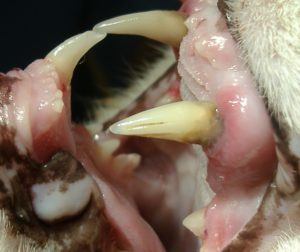
Dental health is a serious issue in veterinary medicine. Cat’s don’t brush their teeth every day. Dog’s don’t floss. As a result, dental disease happens. Most of the adult dogs and cats that we see every day at the Cuyahoga Falls Veterinary Clinic have some degree of dental disease, and it is our goal to provide the help and the relief that they need.
Dental disease is preventable and treatable!
We’ll cover the many aspects of dental health on this blog as time goes by, but we’ll spend this post discussing periodontal disease.
Periodontal disease is the most common health problem that is seen in veterinary medicine, and it is often hidden from our eyes on examination. Periodontal disease occurs when bacteria damages the structures of the bone, tooth and gum tissue beneath the gum-line and down along the tooth root. It causes pain in the mouth, and can lead to disease elsewhere in the body.
Periodontal Disease can be demonstrated with dental radiographs. Note the absence of bone support around the roots.
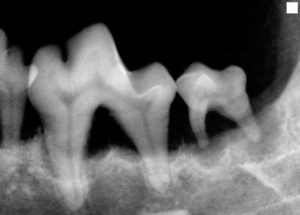
The sraight yellow lines show about where the bone ought to be to sufficiently support the tooth roots. Instead, the bone has resorbed, or literally disappeared, down to the curved yellow lines. Just how much support is the bone providing for the roots? Not much!
But if all of this happens below the gum-line, how can we know to look?
When dental tartar begins to accumulate, when gingivitis (inflammation of the gums) becomes visible, when bad breath is noticeable… these are the times to fully examine the mouth. Below are some examples of what you can look for at home. Photos #1-3 show varying degrees of dental tartar and gingivits. Photo #4 shows significant recession of the gum-line and the bone that ought to be supporting the tooth roots, and the dark spots on the roots are clumps of bacteria.
|
|
|
|
|
|
If these photos resemble something that you’ve seen in your pet’s mouth, do your pet-friend a favor and talk with any of our doctors about what can be done to restore the health of the mouth and the body. There are a number of good, effective ways to combat periodontal disease, and we have the tools to provide a healthy oral environment for your pet-friend.
Remember, the goal is a comfortable, pain-free mouth for your pet!
————
Update: Once a diseased mouth has been treated and returned to a healthy state, there are steps to take at home to prevent dental tartar from returning so quickly.

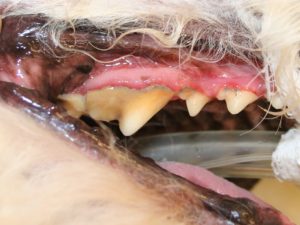
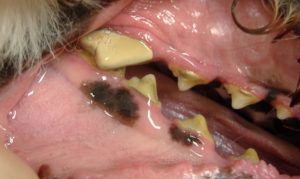

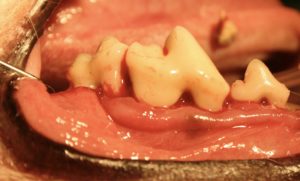
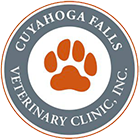
The Cuyahoga Falls Veterinary Clinic | Animal Wellness | Medical Services | Pet Services
[…] no apologies for placing great importance upon dental and oral health and comfort. Whether your pet has periodontal disease or a broken tooth, oral pain must be […]
The Cuyahoga Falls Veterinary Clinic | Animal Wellness | Medical Services | Pet Services
[…] Falls Veterinary Clinic, we are serious about dental and oral health. As we mentioned in our recent Dental Health – Periodontal Disease blog post, periodontal disease is the most common health problem that we find in […]
The Cuyahoga Falls Veterinary Clinic | Animal Wellness | Medical Services | Pet Services
[…] Periodontal Disease is a very common finding in small animal medicine. Many of our patients that come in for routine wellness visits have some degree of periodontal disease. This radiograph shows how the bone has literally left the root and is no longer providing support. […]
The Cuyahoga Falls Veterinary Clinic | Animal Wellness | Medical Services | Pet Services
[…] What was disappointing is that we found kidney disease, pancreatitis, liver disease and extreme dental disease in these patients. All of these are chronic conditions that could have been caught early and […]
The Cuyahoga Falls Veterinary Clinic | Animal Wellness | Medical Services | Pet Services
[…] even as dental tartar accumulates and gingivitis leads to periodontal disease, and even as FRLs emerge and damage particular teeth, cats will continue to eat and will still try […]
The Cuyahoga Falls Veterinary Clinic | Animal Wellness | Medical Services | Pet Services
[…] in the patients we see here at the Cuyahoga Falls Veterinary Clinic. We’ve written about periodontal disease in the past, and how brushing your pet’s teeth (if you’re allowed!) is helpful in […]